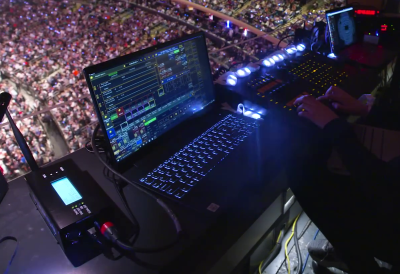LED wristbands are now a common feature of large arena concerts and events, with a variety of capabilities and technical implementations. In the video after the break, Wall Street Journal does a fascinating deep dive into these wearable light shows.
The three main control technologies are IR light, RF radios, and Bluetooth. The IR-controlled ones are the simplest, and we’ve covered a teardown, a reverse engineering effort and reflash of the Pixmob IR armbands.
Finally, we get a good behind-the-scenes look at how they are controlled. Using pan-tilt IR emitters mounted on lighting towers, the operators can sweep across the audience controlling color and light levels or activating pre-programmed sequences.

RF armbands have the simplest control setup, only requiring a single portable transmitter connected to a computer running the control software. It does however require some pre-planning for more complex light displays, to ensure each section of the audience is individually addressable.
The most advanced and expensive versions are handheld light sticks controlled via Bluetooth from an app on the users smartphone, and are popular at K-Pop concerts. Each device is linked to the users seat number, making them individually addressable and allowing the lighting operators to produce complex patterns, and even text, in the crowd.
While each of these devices is simple and underwhelming on its own, tens of thousands working together produce impressive effects and probably hide some hard-earned engineering experience.

















Go to one of those concerts, reverse engineer the infrared messages, and come to the next concert with your own infrared transmitter :-)
My thoughts exactly!
B^)
There was a strip of User Friendly years ago, about Pitr using a huge IR spotlight to flood a tech convention floor with his business card (vcd?)
That was back in the day you could exchange information between PDAs via IR links.
Ah User Friendly, haven’t read them in years (20). I think I will check them out again.
Good luck overpowering a several hundred watt (or more) moving light fixture. If you look in the background of the warehouse you can see several such lights, and if you watch the video further, you can see and hear them talking about directing IR to specific areas. It’s a really neat idea because it allows them to leverage a huge amount of the existing ‘toolchain’ for theatrical and event lighting.
My guess is that they replace the COB LED light source in the fixture with one for IR, refocus the optics, and mod the light’s LED power supply to allow them to modulate the otput.
I demand that my concert ticket be refunded if I am part of the show !
For IR I’m sure they sweep the floor with IR camerae looking for extraneous light sources.
Yeah, no. Nobody’s doing that especially if there aren’t any visible problems, because the chances of someone showing up to disrupt them is very, very small. They also need to have enough power to overwhelm the system’s lights, which are probably tens if not hundreds of watts.
There is a substantial difference between “what my brain thinks up” and “what anyone actually does in the real world.”
As a geek I find this technically really interesting. As a normal person… the amount of e-waste this produces is insane.
At a Coldplay concert they asked for them back for reusing, for what it’s worth
That’s cool for being a passive part of the show, but I still want to see more about the audience being an active part of the show, like at the ’91 Siggraph Electronic Theater (“Audience Participation”).
If the show is about the audience, then does it really matter who is on the stage?
I wonder how feasable it would be to optically map out the locations of randomly distributed wristbands.
I imagine you could periodically run through a sequence of commands for them to light up according to some few bits of their serial number, and have cameras note where in the venue lights changed.
Yeah, seems like that should be possible and shouldn’t even take more than a minute.
I got to see an early prototype years ago (no nda) and forgot about till this article. The prototype used an atmel chip but almost everything else is roughly the same.